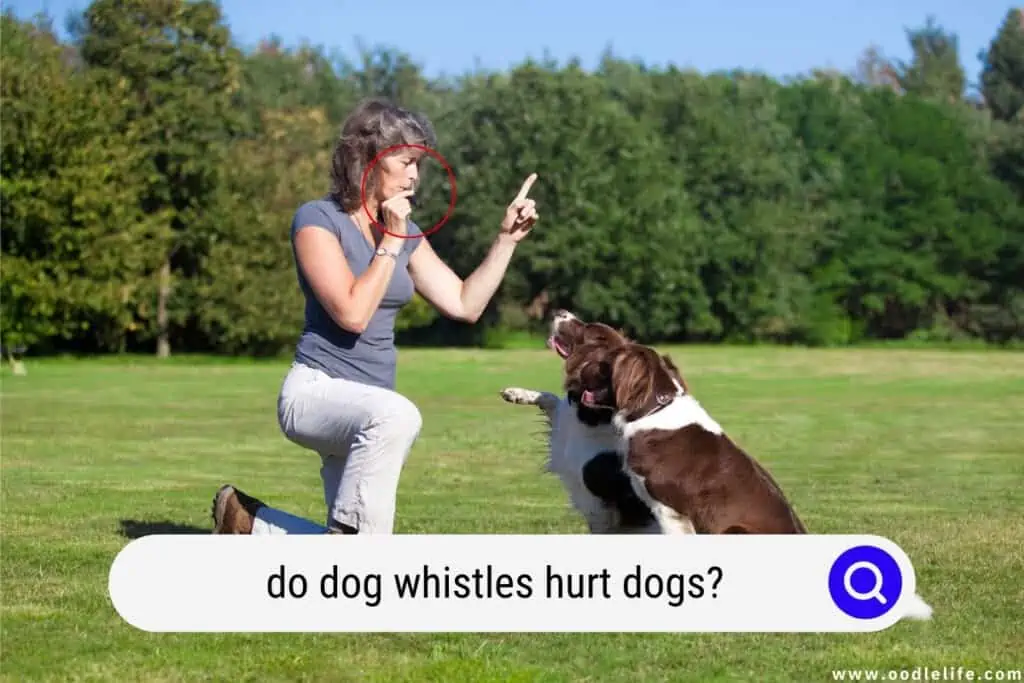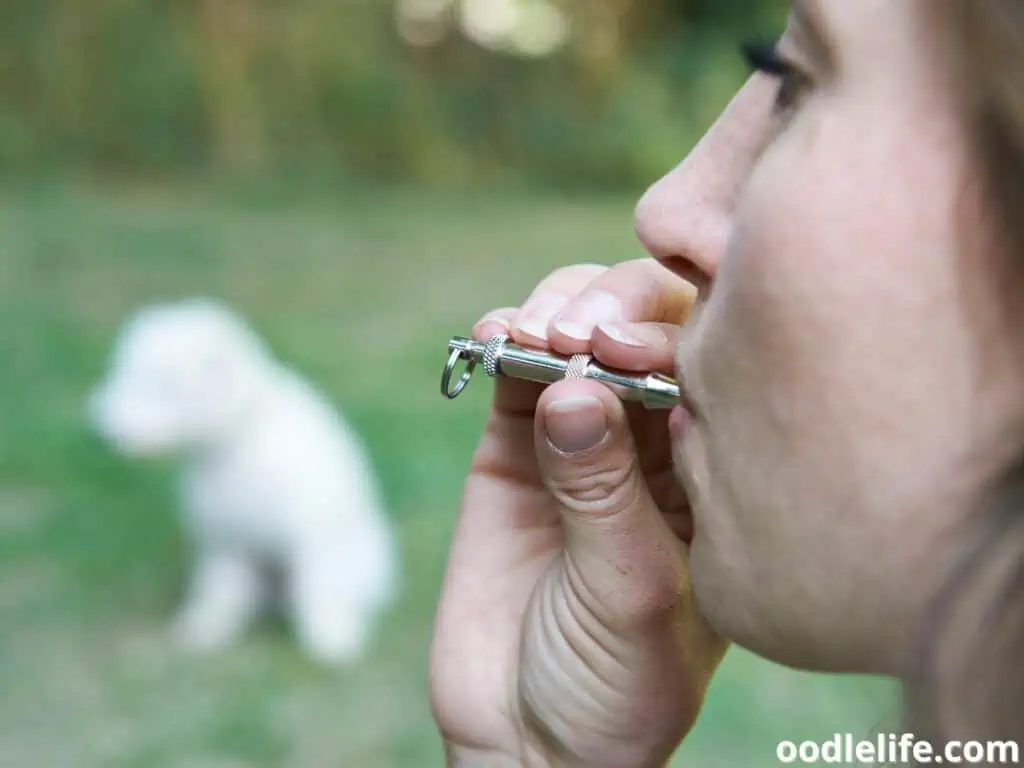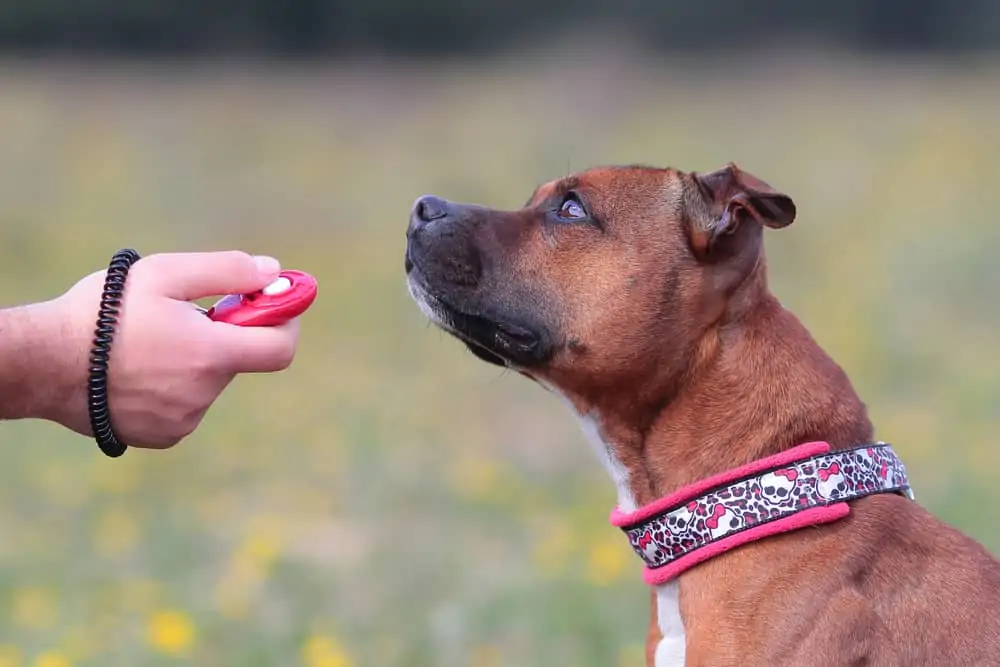Do Dog Whistles HURT Dogs? [Facts]
We love our dogs, and just the thought of us doing something that might unknowingly hurt them makes us all cringy inside.
Of course, the secret to a happy, well-balanced dog is socialization and training. In this, various tools are often employed, one of which is a dog whistle.

Usually made of plastic or metal, these whistles produce a high-pitched sound in a frequency that dogs can hear, but humans cannot.
Dog whistles are used by trainers to get a dog’s attention from a distance or to communicate commands or instructions to a dog.
Dog whistles emit a high-pitched sound that is just above the range of human hearing. While the piercing sound isn’t harmful to humans, it can cause mild discomfort in the sensitive auditory systems of dogs.
In this blog post, we will examine:
- How well do dogs hear?
- Dog vs human hearing
- Do dog whistles hurt dogs?
- How do dog whistles potentially hurt dogs?
- How to properly use a dog whistle?
- Alternative to dog whistles
How Well Do Dogs Hear?
Dogs are renowned for their sharp hearing and sensitive auditory systems. Easily hearing high-frequency sounds beyond humans, they are able to link sounds with different people, situations, or animals.
Canines are known to have almost double the range of audio frequencies that humans have, and in addition, be able to hear sounds four times away.
If you notice your pup’s ears twitching at seemingly nothing, you can be sure that he’s onto something that is beyond your paltry human senses. The design of a dog’s ear itself allows for a better sense of hearing, like the muscles that allow them to twitch their ears to better catch the sound from a particular direction.
Having a sharp sense of hearing is one of the factors that enabled canines to be such prolific hunters since the beginning of time.
You know that absolutely oh-so-adorable head tilt of a dog, and the heart melting way they cock their heads when they look at you questioningly?
They’re actually trying to see and hear you better! It is their way of communicating “wuuuuttt did you just say?!”
Bonus tip (and use sparingly!): Whine as high-pitched (but softly!) as you can while looking at your dog, and you can almost be sure that a head tilt is coming up.

Dog vs Human Hearing
Ever wondered why a dog starts barking a minute before the doorbell rings? Although their sense of hearing is nothing compared to their formidable sense of smell, dogs have incredibly sensitive hearing which allows them to hear footsteps approaching even when humans can hear nothing.
Sounds are a result of air vibrations. High-frequency sounds are produced when vibrations per second are more. Let’s look at the ways human and dogs hearing differentiate:
Sound Frequencies
When it comes to hearing range, a young person can typically hear around 64 – 23,000 Hz whereas dogs can hear a range of 67-45,000.
Muscle Control
Humans have six muscles dedicated to the ear, which hinders their ability to listen to faraway sounds. In comparison, dogs’ ears are controlled by 18 muscles allowing them to move their ears.
Your furry friend can rotate and tilt their ears which helps them hear more efficiently. In addition, the shape of certain dog breeds can assist in amplifying sounds. Some dogs have longer ear canals compared to humans which help them localize a sound, resulting in greater sound accuracy at a longer distance.
Hearing Threshold
While the hearing threshold of dogs is higher than that of humans, they can still hear frequencies that are well above the human range. Dogs have a hearing range of approximately 67-45,000 Hz, while humans can only hear up to about half of the upper limit.
This means that dogs can hear sounds that are way higher in frequency than we can. While this may not seem like a big difference, it can actually be quite significant. For example, a dog whistle emits a sound at a frequency of around 23,000 to 54,000 kHz.
This is just out of the range of human hearing, but dogs can hear this frequency quite easily. This is why dog whistles are so effective at getting a dog’s attention.
Do Dog Whistles Hurt Dogs?
A dog whistle will not hurt your dog if used in a proper way. There are numerous types of whistles accessible in the market.
It is imperative to go through the information provided by the manufacturer for proper usage. In addition, you should also consult with your vet and clarify any doubts you have before using dog whistles.
Given that dogs have sensitive hearing, they can hear sounds from the whistle which are inaudible to humans. These high-frequency sounds can be unpleasant to a pup but are unlikely to harm your dog’s brain or ears.
Even though dog whistles are not cruel, it is crucial to be mindful of the way these sounds impact other pets around the house or in the neighborhood. For instance, cats can hear as well as dogs, which can make whistle sounds uncomfortable and disruptive for them.

How Do Dog Whistles Potentially Hurt Dogs?
Like any other object, incorrect and excessive use of a dog whistle can hurt your dog and impair their ability to hear. Whistles can be harmful to humans when blown really close to the ear. Pet whistles work in a similar method.

Dog whistles can be harmful to your furry friend in the following ways:
Blowing the Whistle Loudly
Just like a normal whistle that can blow our ears out when someone gets over-enthusiastic, dog whistles are similar to normal whistles and can startle a dog when blown too loud.
Proximity
Heard the referee blowing the whistle on a football ground? Imagine the same whistle being blown directly in your ear. Not only can it damage the sensitive inner ears, but it can also bring permanent injury.
Blowing a whistle directly into or near a dog’s ear can bring immense discomfort and even permanently damage their sense of hearing.
Usage Duration
Some dog parents are concerned about the high-frequency sounds that emit from a dog whistle, believe that constant sounds from whistles can damage dog ears.
Excessive use of the whistle can be counterproductive and cause your pup to ignore it, rendering it ineffective. In addition, long periods of constant use might damage your dog’s ear, especially if blown loudly and or in close proximity.
How To Properly Use A Dog Whistle?
It is tricky for first-time pet parents to understand the intensity with which these whistles should be blown. Given that humans can’t hear these sounds, you might unintentionally blow it too loudly and frequently.

Begin Gently
Blowing the whistle too hard can impair your dog’s hearing or irritate them. While it is tempting to blow as hard as you can, it is important to remember you can’t hear the whistle, and what you cannot hear might sound like a giant foghorn to your dog.
In order to prevent damage to your dog’s ear, it is best to invest in a beginner’s whistle which makes it difficult to be too loud, reducing the risk of hurting your dog unintentionally. Beginner dog whistles are perfect for first-time pet parents who are learning to use these whistles.
Never blow directly into or near your dog’s ears.
Volume and distance from the sound are two main factors that can hurt your pet’s hearing. It is crucial to be mindful of the whistleblowing intensity and ensure that you do not blow it close to your dog’s ear.
If you are too close to your dog, the high-frequency sounds from the whistle can damage the eardrums. It is recommended to blow the whistle standing up, blowing it lightly, and making sure that your dog is at a distance.
Don’t use it in a confined space.
Just like our loud noises bounce off the walls, so do high-frequency whistles that we are unable to hear.
With their sensitive hearing, the whistle can impair your dog’s hearing and if they exhibit discomfort, stop using the whistle immediately.
Professional Trainer
Hiring a professional trainer will help you better understand the mechanics of a dog whistle and help you properly use the device to train your pup.
Alternatives To Dog Whistles
Every dog is different and will require individualized training techniques and tools. If the dog whistle isn’t working with you and your dog, you can try these other methods as training aids.
Vibration Dog Collar
These handy devices can help train your dog and discourage bad behavior. Using a remote control, you can activate the collar to emit a short, harmless vibration. This swiftly gets your dog’s attention and let’s them know that they’re doing something wrong.

Clickers
A dog clicker is a small hand-held device that makes a clicking noise when pressed. The clicker is used to train dogs by associating the sound with a positive behavior, such as receiving a treat.
A clicker can be a useful tool for teaching tricks or obedience commands, and it can also be used to help break bad habits, such as barking or jumping up on people.

Final Thoughts On Dog Whistles
Like any training tool, dog whistles must be used with the proper know-how in order to be effective. What makes whistles tricky is that they are inaudible to the human ear, and we cannot gauge whether the signal is effective or not.
Always err to the side of caution and avoid blowing the whistle too loudly or constantly, and stay far, FAR away from your dog’s ears. Happy training, and good luck!
